Gallery
- Radha Crosses a River to Interview a Hindu Sage, c. 1820
- Escapade at night, c. 1800 – c. 1810
- The Battle of Haldighati, c. 1810 – c. 1820
Chokha was an early 19th-century painter of Rajasthan in India. He was the son of Bakta, also a painter, and produced works for both the courts of Mewar and Devgarh. [1] [2] [3]
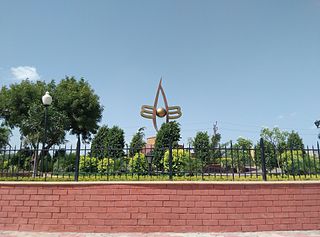
Nathdwara is a city in the western state of Rajasthan, India. It is located in the Aravalli hills, on the banks of the Banas River in Rajsamand District, 48 kilometres north-east of Udaipur. Shrinathji, is a swarup of lord Krishna which resembles his 7-year-old "infant" incarnation of Krishna. The deity was originally worshiped at Mathura and was shifted in the 1672 from Govardhan hill, near Mathura along holy river Yamuna after being retained at Agra for almost six months. Literally, Nathdwara means 'Gateway to Shrinathji (God)'. Nathdwara is a significant Vaishnavite shrine pertaining to the Pushti Marg or the Vallabh Sampradaya or the Shuddha Advaita founded by Vallabha Acharya, revered mainly by people of Gujarat and Rajasthan, among others. Vitthal Nathji, son of Vallabhacharya institutionalised the worship of Shrinathji at Nathdwara. Today also the Royal king family of Nathdwara belongs to the lineage of vallabhacharya mahaprabhuji. They are called Tilkayat or tikaet of Nathdwara.

Pratap Singh I, popularly known as Maharana Pratap, was a king of Mewar from the Sisodia dynasty. Pratap became a folk hero for his military resistance against the expansionism of the Mughal Empire under Akbar through guerrilla warfare which proved inspirational for later rebels against Mughals including Shivaji.

Mughal painting is a particular style of South Asian, particularly North Indian, painting confined to miniatures either as book illustrations or as single works to be kept in albums (muraqqa). It emerged from Persian miniature painting and developed in the court of the Mughal Empire of the 16th to 18th centuries. Battles, legendary stories, hunting scenes, wildlife, royal life, mythology, as well as other subjects have all been frequently depicted in paintings.
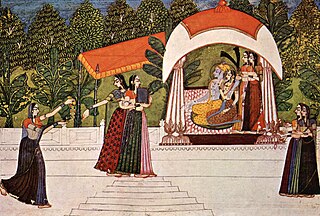
Rajput painting, also called Rajasthan painting, evolved and flourished in the royal courts of Rajputana in northern India, mainly during the 17th century. Artists trained in the tradition of the Mughal miniature were dispersed from the imperial Mughal court, and developed styles also drawing from local traditions of painting, especially those illustrating the Hindu religious epics, the Mahabharata and Ramayana.
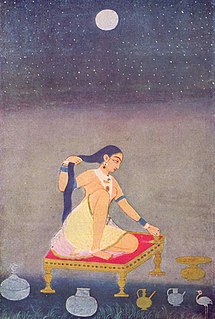
Indian painting has a very long tradition and history in Indian art, though because of the climatic conditions very few early examples survive. The earliest Indian paintings were the rock paintings of prehistoric times, such as the petroglyphs found in places like Bhimbetka rock shelters. Some of the Stone Age rock paintings found among the Bhimbetka rock shelters are approximately 10,000 years old.

Francis Danby was an Irish painter of the Romantic era. His imaginative, dramatic landscapes were comparable to those of John Martin. Danby initially developed his imaginative style while he was the central figure in a group of artists who have come to be known as the Bristol School. His period of greatest success was in London in the 1820s.

Maharana Hammir (1314–1364), or Hammir, was a 14th-century Hindu Rajput ruler of Mewar in present-day Rajasthan, India. Hammir Singh, was a scion of the cadet branch Rana of the Guhila dynasty, who regained control of the region, re-established the dynasty after defeating the Tughlaq dynasty, and captured present-day Rajasthan from Muslim forces of Delhi and became the first of the 'Rana' branch to become the King of Mewar with title of Maharana. Hammir also became the progenitor of the Sisodia clan, a branch of the Guhila dynasty, to which every succeeding Maharana of Mewar has belonged. Mewar during Rana Hammirs reign, was one of the few ethnic Indian states that had withstood the Turkic invasions. According to John Darwin "Only in Mewar and in Vijaynagar had Hindu states withstood the deluge".
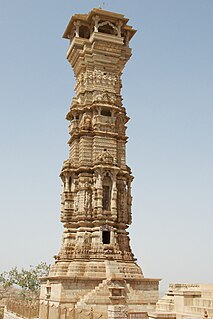
Kirti Stambha is a 12th-century tower situated at Chittor Fort in Chittorgarh town of Rajasthan, India.

Company style or Company painting is a term for a hybrid Indo-European style of paintings made in India by Indian artists, many of whom worked for European patrons in the British East India Company or other foreign Companies in the 18th and 19th centuries. The style blended traditional elements from Rajput and Mughal painting with a more Western treatment of perspective, volume and recession. Most paintings were small, reflecting the Indian miniature tradition, but the natural history paintings of plants and birds were usually life size.

Sahibdin was an Indian miniature painter of the Mewar school of Rajasthan painting. He was one of the dominant painters of the era, and one of the few whose name is still known today. Sahibdin was a Muslim, but that kept neither his Hindu patrons from employing him, nor him from composing Hindu-themed works of great value. Sahibdin's paintings deftly combine elements of the "popular Mughal" style then in vogue across northern India with the traditional Rajput style.

City Palace, Udaipur is a palace complex situated in the city of Udaipur in the Indian state of Rajasthan. It was built over a period of nearly 400 years, with contributions from several rulers of the Mewar dynasty. Its construction began in 1553, started by Maharana Udai Singh II of the Sisodia Rajput family as he shifted his capital from the erstwhile Chittor to the newfound city of Udaipur. The palace is located on the east bank of Lake Pichola and has several palaces built within its complex.

Ragamala paintings are a form of Indian miniature painting, a set of illustrative paintings of the Ragamala or "Garland of Ragas", depicting variations of the Indian musical modes called ragas. They stand as a classical example of the amalgamation of art, poetry and classical music in medieval India.
Rajasthani people or Rajasthanis are an Indian ethnic group native to Rajasthan, a state in Northern India. Their language, Rajasthani, is a part of the western group of Indo-Aryan languages.
Thomas Leeson Scrase Rowbotham (1782–1853) was an English watercolourist and oil painter. He was a skilled painter of landscapes and marine subjects, became professor of drawing at the Royal Naval School and produced books on painting and drawing. He contributed 258 watercolours of scenes from Bristol, England to the topographical collection of George Weare Braikenridge. The Braikenridge Collection makes Bristol's early 19th century appearance one of the best documented of any English city.
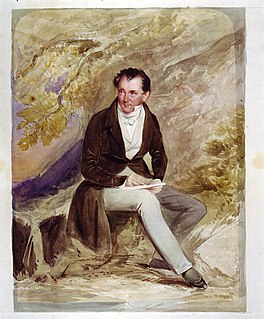
Samuel Jackson was an English watercolourist and oil painter who has been called the "father" of the Bristol School of art. He also contributed a number of drawings of scenes from Bristol to the topographical collection of George Weare Braikenridge. The Braikenridge Collection makes Bristol's early 19th-century appearance one of the best documented of any English city.

Narottam Narayan Sharma was an Indian artist from Nathdwara. He is especially famous for his images of Krishna, which were popular throughout North India and were even more influential than the works of Raja Ravi Varma.

Apart from the architecture of Rajasthan, the most notable forms of the visual art of Rajasthan are architectural sculpture on Hindu and Jain temples in the medieval era, in painting illustrations to religious texts, beginning in the late medieval period, and post-Mughal miniature painting in the Early Modern period, where various different court schools developed, together known as Rajput painting. In both cases, Rajasthani art had many similarities to that of the neighbouring region of Gujarat, the two forming most of the region of "Western India", where artistic styles often developed together.

Nathdwara Painting refers to a painting tradition and school of artists that emerged in Nathdwara, a town in Rajsamand district in the Western state of Rajasthan in India. Nathdwara paintings are of different sub-styles of which Pichhwai paintings are the most popular. The word Pichwai derives from the Sanskrit words pich meaning back and wais meaning hanging. These paintings are cloth paintings hung behind the image of the Hindu god Shrinathji.
Jangid Brahmin is a subcaste of Adi Gaur Brahmins. They have a notable presence in the states of Haryana, Rajasthan and Punjab and their traditional occupation was that of carpentry, especially woodcarving and furniture making. Today, the Jangid in Rajasthan are usually known for painting and decorative works such as making seats or chariots for religious figurines. The Government of Rajasthan lists the Jangid as Jangid brahmins in OBC.

Deccan painting or Deccani painting is the form of Indian miniature painting produced in the Deccan region of Central India, in the various Muslim capitals of the Deccan sultanates that emerged from the break-up of the Bahmani Sultanate by 1520. These were Bijapur, Golkonda, Ahmadnagar, Bidar, and Berar. The main period was between the late 16th century and the mid-17th, with something of a revival in the mid-18th century, by then centred on Hyderabad.
| Wikimedia Commons has media related to Chokha (painter) . |